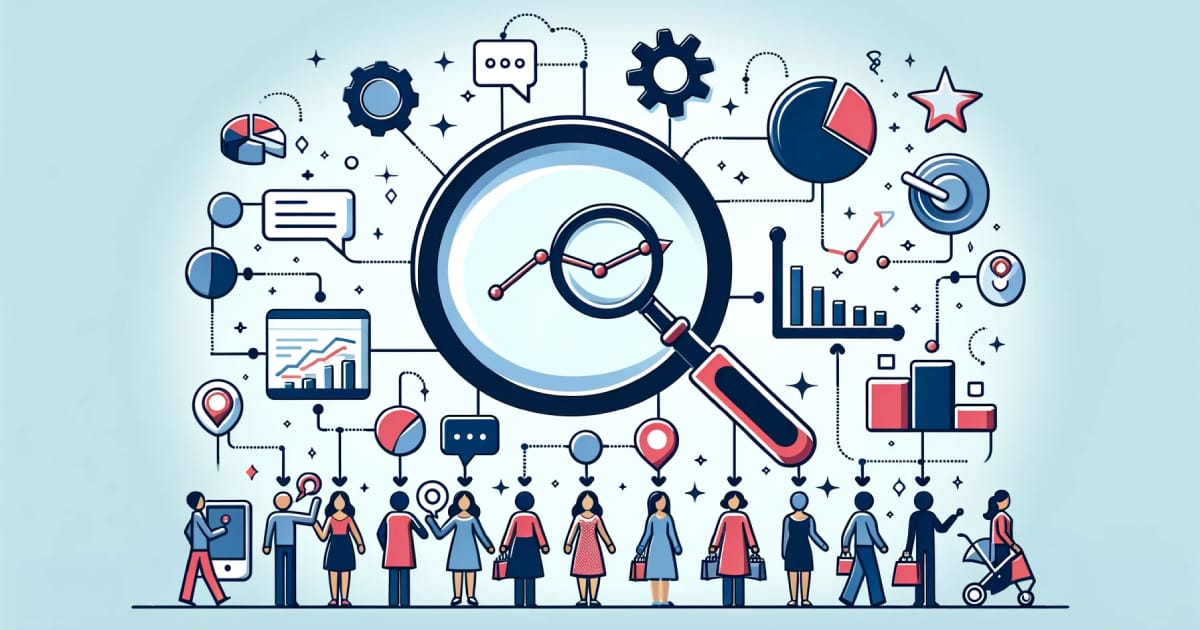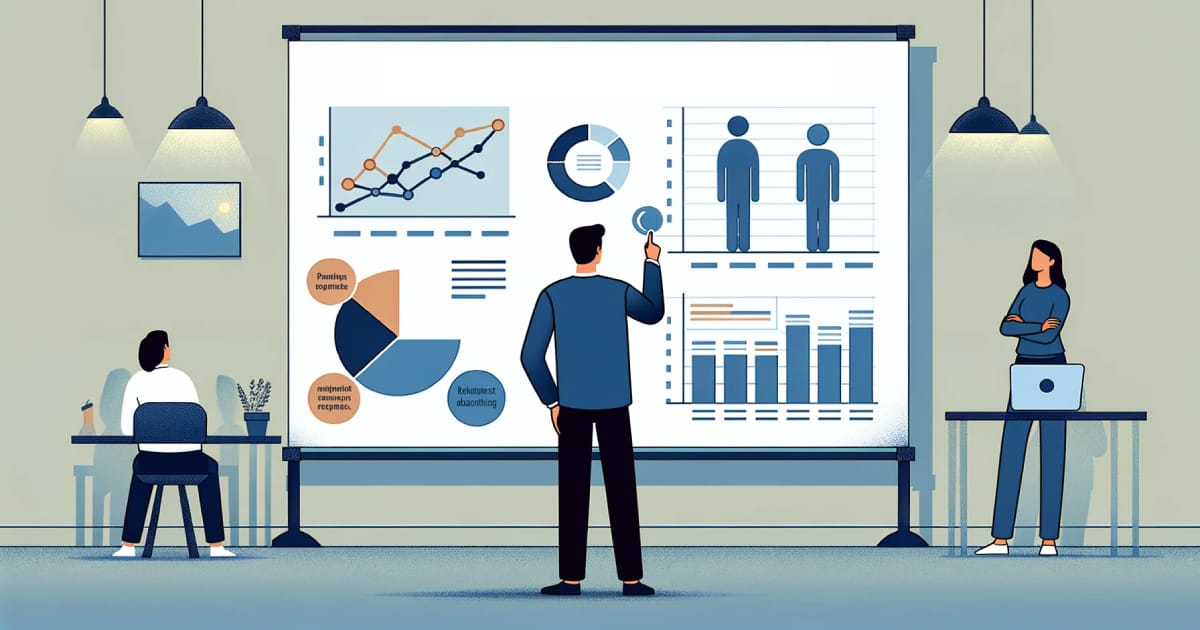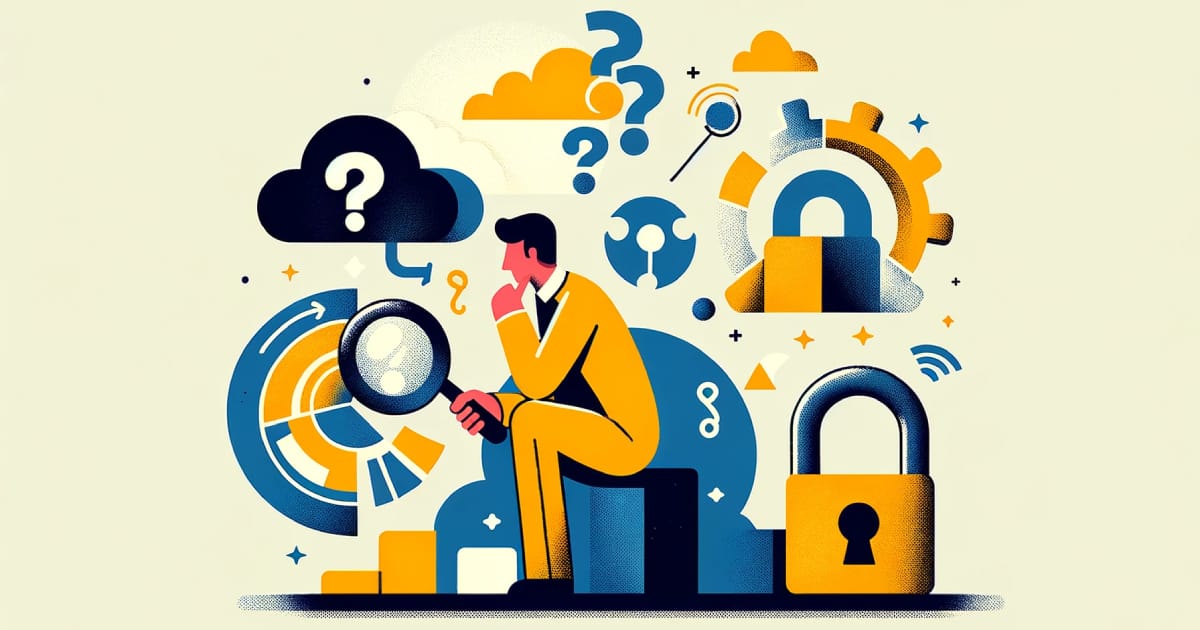Customer Behavior Analysis [Complete Guide 2024]
![Cosmico - Customer Behavior Analysis [Complete Guide 2024]](/content/images/size/w1200/2024/02/customer_behavior_analysis_2024_complete_guide_cosmico_business_tech_insights.jpg)
Customer Behavior Analysis (CBA) is essential for understanding customer habits, preferences, and motivations, helping businesses tailor their marketing, product development, and customer service. By analyzing data from sources like online shopping patterns and social media interactions, companies can identify trends and adjust strategies accordingly.
In a competitive market, CBA offers a significant advantage by enabling personalized marketing, relevant product development, and improved customer service. This leads to higher customer satisfaction and loyalty, making CBA a key component of effective business strategies.
Understanding Customer Behavior

Understanding customer behavior is fundamental to effective marketing and business strategy. It involves examining the various factors that influence how consumers make purchasing decisions and interact with brands. These factors can be broadly categorized into psychological, social, personal, and cultural influences. By comprehensively analyzing these elements, businesses can anticipate customer needs, tailor their offerings, and improve customer engagement.
Psychological Factors
Psychological factors play a crucial role in shaping customer behavior. These include:
- Motivation: The driving force behind a consumer's decision to seek out and purchase a product or service. Understanding what motivates customers helps businesses create products and marketing messages that resonate with their target audience.
- Perception: How customers interpret information and form impressions about products and services. Perception is influenced by marketing communications, social media, reviews, and personal experiences.
- Learning: The process through which consumers change their behavior based on experiences. Brands that effectively educate and engage customers can influence future purchasing decisions.
- Beliefs and Attitudes: The personal judgments and feelings towards products or brands. These are shaped by past experiences, advertising, and word-of-mouth, and they significantly affect buying behavior.
Social Factors
Social factors refer to the effects of society, including family, friends, and other reference groups, on consumer behaviors:
- Reference Groups: Groups that individuals compare themselves to or are influenced by, which can affect product choices and brand perceptions.
- Family: Family members significantly impact buying decisions, from products for personal use to household items.
- Roles and Status: An individual's position within a group can influence their purchases, often to reflect or enhance their status.
Personal Factors
Personal factors are individual characteristics that differentiate consumers from one another, affecting their buying decisions:
- Age and Life-Cycle Stage: Consumer preferences and spending habits change as individuals move through life stages.
- Occupation and Economic Circumstances: A person's career and financial stability influence their purchasing power and preferences.
- Personality and Self-Concept: The unique personality traits and self-image of consumers can drive their brand preferences and loyalty.
Cultural Factors
Cultural factors are the broader societal aspects that affect consumer behavior:
- Culture: The fundamental determinant of a person's wants and behavior. Businesses must understand cultural nuances to effectively market products in different regions.
- Subculture: Groups within larger cultures with shared values. Marketing strategies can be tailored to appeal to specific subcultures.
- Social Class: Often determined by income, education, and occupation, social class affects consumers' perceptions and buying habits.

By analyzing these factors, businesses can gain a deeper understanding of their customers, enabling them to develop more effective marketing strategies, product designs, and customer service approaches. This understanding leads to enhanced customer satisfaction and loyalty, driving long-term business success.
Methods of Analyzing Customer Behavior

Analyzing customer behavior is essential for businesses seeking to understand their audience deeply and improve their products, services, and marketing strategies. There are several methods through which businesses can gather insights about their customers, ranging from qualitative and quantitative research to observational studies. Each method provides a different lens through which customer behavior can be understood, offering valuable data that can inform decision-making processes.
Qualitative Research
Qualitative research methods focus on understanding the 'why' behind customer behaviors, offering insights into customers' attitudes, feelings, and motivations.
- Interviews: One-on-one conversations with customers provide deep insights into their thoughts and feelings about products, services, or brands. These interactions can uncover underlying motivations and dissatisfaction points not evident in quantitative data.
- Focus Groups: Small, diverse groups of people are brought together to discuss their perceptions, opinions, and attitudes towards a product or service. Moderators can probe deeper into specific areas of interest, gaining a nuanced understanding of customer behavior.
Quantitative Research
Quantitative research methods involve the collection and analysis of numerical data to identify patterns, trends, and correlations in customer behavior.
- Surveys and Questionnaires: These tools can gather data from a large number of customers, providing insights into preferences, purchasing habits, and satisfaction levels. Surveys can be distributed online, via email, or in person, making them a versatile tool for gathering customer feedback.
- Behavioral Data Analysis: The analysis of data generated by customers’ interactions with websites, apps, and products. This includes website visit patterns, purchase histories, and usage data. Tools like Google Analytics can track user actions, providing businesses with concrete data on customer behavior online.
Observational Research
Observational research involves directly observing customers in their natural environment without interference. This method can provide insights into how customers interact with products or services in real life.
- Ethnographic Studies: Researchers immerse themselves in the customer's environment, observing behaviors and interactions in real-world settings. This can provide deep insights into customer needs, frustrations, and usage patterns.
- Web Analytics: The use of tools to track and analyze how users interact with a website or app. This can include which pages they visit, how long they stay, and the path they take through a site. Web analytics can reveal problems in the user experience and opportunities to improve engagement.
Each of these methods has its strengths and can be used independently or in combination to gain a comprehensive understanding of customer behavior. The choice of method depends on the specific objectives of the analysis, the nature of the product or service, and the resources available to the business.
Tools and Technologies for Customer Behavior Analysis

With advancements in technology, a variety of tools and platforms have emerged to aid businesses in analyzing customer behavior. These tools can process large volumes of data, providing insights that were previously difficult or impossible to obtain.
- CRM Systems: Customer Relationship Management (CRM) systems collect and manage customer data across different points of interaction. These systems can track customer preferences, purchase history, and communication, offering a 360-degree view of the customer journey.
- Analytics and Data Visualization Tools: Tools like Google Analytics, Tableau, and Power BI can analyze large datasets, identifying trends and patterns in customer behavior. Data visualization helps in making complex data more understandable and actionable.
- AI and Machine Learning Models: Artificial intelligence and machine learning can predict customer behavior, personalize marketing messages, and identify emerging trends. These technologies can analyze unstructured data, such as social media posts and customer reviews, providing deeper insights into customer sentiments and preferences.
Applying these tools effectively requires a strategic approach, where data collected is analyzed with specific business goals in mind. By leveraging these technologies, businesses can enhance customer experience, tailor marketing strategies, and ultimately, drive growth and profitability.
Applying Customer Behavior Analysis

The insights gained from customer behavior analysis can significantly impact various business areas, from marketing and sales to product development and customer service. This section explores how businesses can leverage these insights to drive strategy and innovation.
Enhancing Customer Experience
One of the primary applications of customer behavior analysis is in enhancing the overall customer experience. By understanding the needs, preferences, and pain points of their customers, businesses can:
- Personalize Interactions: Tailor communications and offers to individual customer preferences, increasing engagement and loyalty.
- Optimize User Experience (UX): Use data on how customers interact with websites and apps to make navigational improvements, reduce friction points, and streamline the buying process.
- Improve Customer Service: Anticipate common issues and questions, enabling faster and more effective customer support.
Product Development and Innovation
Insights into customer behavior can also drive product development and innovation by identifying unmet needs and future market trends.
- Identify New Product Opportunities: Understand emerging needs and preferences to develop new products or services that address gaps in the market.
- Enhance Existing Offerings: Use customer feedback and usage patterns to refine and improve current products, adding features or making changes that increase satisfaction and utility.
Marketing Strategy and Personalization
A deep understanding of customer behavior is crucial for developing effective marketing strategies that resonate with the target audience.
- Targeted Marketing Campaigns: Segment customers based on their behaviors and preferences to create more relevant and compelling marketing messages.
- Content Personalization: Tailor content on websites and in email marketing to reflect the interests and behaviors of individual customers, increasing engagement and conversion rates.
Sales Strategy
Customer behavior analysis can also inform sales strategies, enabling businesses to better meet the needs of their customers and close more deals.
- Sales Forecasting: Use historical purchasing data to predict future sales trends and adjust inventory and marketing efforts accordingly.
- Cross-selling and Upselling: Identify patterns in customer purchasing behavior to offer complementary or premium products at the right time.
Challenges in Customer Behavior Analysis

Despite its benefits, analyzing customer behavior comes with challenges that businesses must navigate carefully.
- Data Privacy and Security: With increasing concerns over data privacy, businesses must ensure their data collection and analysis practices comply with legal standards and respect customer privacy.
- Integrating Data from Multiple Sources: Consolidating data from various channels into a cohesive analysis can be complex and requires sophisticated data management tools.
- Keeping up with Changing Customer Expectations: Customer preferences and behaviors evolve rapidly, making it crucial for businesses to continuously analyze and adapt to these changes.
Case Studies and Success Stories

To illustrate the impact of customer behavior analysis, consider these examples:
- Retail Example: A retail company used customer behavior data to personalize email marketing campaigns, resulting in a 20% increase in open rates and a 10% increase in conversion rates.
- E-commerce Example: An e-commerce platform implemented changes based on user behavior analysis, leading to a 30% reduction in cart abandonment rate and a significant increase in average order value.
- Hospitality Example: A hotel chain tailored promotional offers based on guests' previous preferences, leading to a 15% increase in repeat bookings and a 25% rise in guest satisfaction.
- Financial Services Example: By analyzing transaction data to identify spending habits, a credit card company offered targeted rewards, resulting in a 30% increase in card usage and improved customer loyalty.
- Technology Sector Example: An online streaming service personalized content recommendations based on viewer habits, achieving a 40% increase in engagement and a 20% reduction in cancellations.
- Automotive Industry Example: A car manufacturer analyzed data from connected vehicles to offer customized maintenance plans, leading to a 50% increase in customer satisfaction and a 35% uptick in loyalty.
Final Thoughts
Customer behavior analysis is a powerful tool for businesses looking to understand their customers deeply and tailor their strategies accordingly. As technology evolves, we can expect even more sophisticated tools and methods to emerge, offering deeper insights and new opportunities for personalization and engagement.
The future of customer behavior analysis lies in the integration of AI and machine learning, the increasing importance of data privacy, and the continuous need for innovation in how businesses understand and interact with their customers. By staying ahead of these trends, companies can not only meet but exceed customer expectations, securing their loyalty and driving long-term success.
Key Takeaways
| Section | Key Takeaways |
|---|---|
| Introduction | CBA helps tailor products and strategies to customer needs, boosting satisfaction and profitability. |
| Understanding Customer Behavior | Psychological, social, personal, and cultural factors influence customer actions, key for marketing. |
| Methods of Analysis | Qualitative, quantitative, and observational research are vital for understanding customer behavior. |
| Tools and Technologies | CRM systems, analytics tools, and AI models are crucial for analyzing customer behavior. |
| Applying CBA | CBA insights improve customer experience, product development, and marketing strategies. |
| Challenges | Data privacy, integrating multiple sources, and adapting to customer changes are major challenges. |
| Case Studies | Success stories show how CBA leads to better engagement, sales, and customer satisfaction. |
| Final Thoughts | The future of CBA focuses on AI, machine learning, and data privacy, requiring constant innovation. |
Top Books on Customer Behavior
- "Predictably Irrational: The Hidden Forces That Shape Our Decisions" by Dan Ariely: This book explores the irrational aspects of human decision-making and how they influence consumer behavior. Ariely delves into various psychological experiments and studies to uncover the predictable patterns behind seemingly irrational decisions, offering insights valuable for understanding consumer behavior.
- "Nudge: Improving Decisions About Health, Wealth, and Happiness" by Richard H. Thaler and Cass R. Sunstein: Thaler and Sunstein present the concept of "nudging," which involves designing choices in a way that influences people to make better decisions without restricting their freedom of choice. They delve into behavioral economics and psychology to provide practical insights on how businesses and policymakers can use nudges to steer consumer behavior towards more desirable outcomes.
- "Hooked: How to Build Habit-Forming Products" by Nir Eyal: This book focuses on the psychology behind building habit-forming products and services. Eyal introduces the "Hook Model," a framework that explains how certain products create user habits by triggering specific behaviors. Understanding this model can help businesses design products and marketing strategies that effectively engage and retain customers.
- "The Power of Habit: Why We Do What We Do in Life and Business" by Charles Duhigg: Duhigg explores the science behind habits and how they shape individual and organizational behavior. He delves into case studies from various fields, including marketing and consumer behavior, to illustrate how habits influence consumer choices and how businesses can leverage this knowledge to create more effective marketing campaigns and products.
- "Influence: The Psychology of Persuasion" by Robert B. Cialdini: Cialdini examines the principles of influence and persuasion, outlining six key principles that drive human behavior. Through engaging anecdotes and scientific research, he explains how these principles can be applied to marketing and sales to influence customer behavior effectively. Understanding these principles can empower businesses to craft more compelling marketing messages and strategies.





